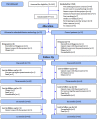Cardiac Patients' Walking Activity Determined by a Step Counter in Cardiac Telerehabilitation: Data From the Intervention Arm of a Randomized Controlled Trial
- PMID: 27044310
- PMCID: PMC4835668
- DOI: 10.2196/jmir.5191
Cardiac Patients' Walking Activity Determined by a Step Counter in Cardiac Telerehabilitation: Data From the Intervention Arm of a Randomized Controlled Trial
Abstract
Background: Walking represents a large part of daily physical activity. It reduces both overall and cardiovascular diseases and mortality and is suitable for cardiac patients. A step counter measures walking activity and might be a motivational tool to increase and maintain physical activity. There is a lack of knowledge about both cardiac patients' adherence to step counter use in a cardiac telerehabilitation program and how many steps cardiac patients walk up to 1 year after a cardiac event.
Objective: The purpose of this substudy was to explore cardiac patients' walking activity. The walking activity was analyzed in relation to duration of pedometer use to determine correlations between walking activity, demographics, and medical and rehabilitation data.
Methods: A total of 64 patients from a randomized controlled telerehabilitation trial (Teledi@log) from Aalborg University Hospital and Hjoerring Hospital, Denmark, from December 2012 to March 2014 were included in this study. Inclusion criteria were patients hospitalized with acute coronary syndrome, heart failure, and coronary artery bypass grafting or valve surgery. In Teledi@log, the patients received telerehabilitation technology and selected one of three telerehabilitation settings: a call center, a community health care center, or a hospital. Monitoring of steps continued for 12 months and a step counter (Fitbit Zip) was used to monitor daily steps.
Results: Cardiac patients walked a mean 5899 (SD 3274) steps per day, increasing from mean 5191 (SD 3198) steps per day in the first week to mean 7890 (SD 2629) steps per day after 1 year. Adherence to step counter use lasted for a mean 160 (SD 100) days. The patients who walked significantly more were younger (P=.01) and continued to use the pedometer for a longer period (P=.04). Furthermore, less physically active patients weighed more. There were no significant differences in mean steps per day for patients in the three rehabilitation settings or in the disease groups.
Conclusions: This study indicates that cardiac telerehabilitation at a call center can support walking activity just as effectively as telerehabilitation at either a hospital or a health care center. In this study, the patients tended to walk fewer steps per day than cardiac patients in comparable studies, but our study may represent a more realistic picture of walking activity due to the continuation of step counter use. Qualitative studies on patients' behavior and motivation regarding step counter use are needed to shed light on adherence to and motivation to use step counters.
Trial registration: ClinicalTrials.gov NCT01752192; https://clinicaltrials.gov/ct2/show/NCT01752192 (Archived by WebCite at http://www.webcitation.org/6fgigfUyV).
Keywords: heart disease; physical activity; rehabilitation; step counters; telerehabilitation.
Conflict of interest statement
Conflicts of Interest: None declared.
Figures




References
-
- World Health Organization. 2014. May, [2015-09-09]. The top 10 causes of death http://www.who.int/mediacentre/factsheets/fs310/en/ - PubMed
-
- Piepoli MF, Corrà U, Benzer W, Bjarnason-Wehrens B, Dendale P, Gaita D, McGee H, Mendes M, Niebauer J, Zwisler AO, Schmid J, Cardiac Rehabilitation Section of the European Association of Cardiovascular PreventionRehabilitation Secondary prevention through cardiac rehabilitation: from knowledge to implementation. A position paper from the Cardiac Rehabilitation Section of the European Association of Cardiovascular Prevention and Rehabilitation. Eur J Cardiovasc Prev Rehabil. 2010 Feb;17(1):1–17. doi: 10.1097/HJR.0b013e3283313592. - DOI - PubMed
-
- Beatty AL, Fukuoka Y, Whooley MA. Using mobile technology for cardiac rehabilitation: a review and framework for development and evaluation. J Am Heart Assoc. 2013;2(6):e000568. doi: 10.1161/JAHA.113.000568. http://jaha.ahajournals.org/cgi/pmidlookup?view=long&pmid=24185949 jah3359 - DOI - PMC - PubMed
-
- Scalvini S, Zanelli E, Comini L, Dalla TM, Troise G, Febo O, Giordano A. Home-based versus in-hospital cardiac rehabilitation after cardiac surgery: a nonrandomized controlled study. Phys Ther. 2013 Aug;93(8):1073–1083. doi: 10.2522/ptj.20120212. http://www.ptjournal.org/cgi/pmidlookup?view=long&pmid=23599353 ptj.20120212 - DOI - PubMed
Publication types
MeSH terms
Associated data
LinkOut - more resources
Full Text Sources
Other Literature Sources
Medical
Miscellaneous

